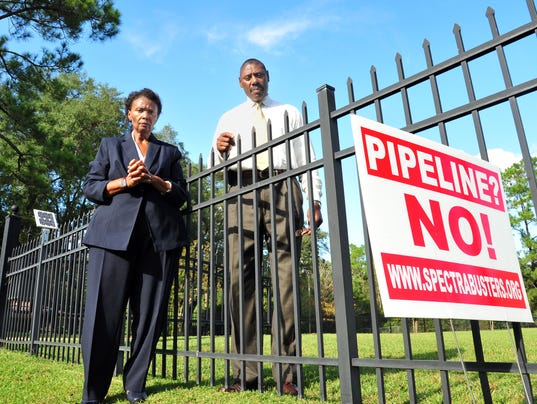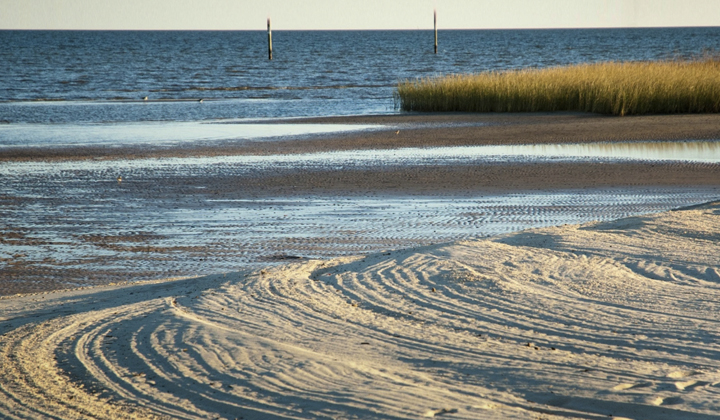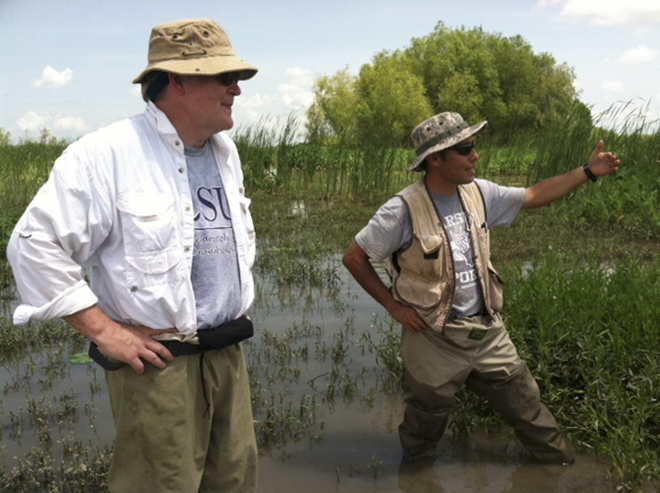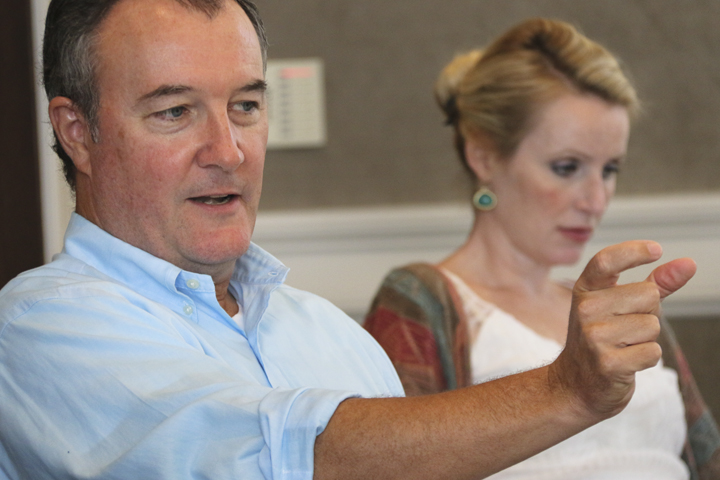E&E
$627M in restoration projects receive final approval
Annie Snider, E&E reporter
Published: Friday, October 3, 2014
Hundreds of millions of dollars will soon be flowing to the Gulf
Coast after the largest tranche of restoration projects related to
the 2010 Gulf of Mexico oil spill today received its final go-ahead.
Federal and state officials charged with studying the effects of the
spill and developing plans for recovery projects today issued their
record of decision for 44 projects totaling $627 million.
The projects are spread across the Gulf of Mexico and range from
creating barrier islands off the Louisiana coast to building a
causeway and beachfront promenade in Mississippi. They are part of
the unprecedented agreement with BP PLC under which the company
provided a $1 billion down payment on what it will owe through the
Natural Resource Damage Assessment (NRDA) process for destruction to
natural resources and lost human access to beaches and fisheries.
“The Trustees have done a comprehensive job of identifying projects
to help the Gulf Coast recover from the devastating Deepwater Horizon
spill and have given careful consideration to the many insightful
public comments received through the process,” Interior Secretary
Sally Jewell said in a statement.
Her department will see some of the money for work on two national
seashore projects and a barrier island.
Environmental groups have largely been pleased to have new
restoration projects moving forward after having seen only a handful
of projects approved in the first two phases of awards. Groups have
raised concerns, though, that the projects have been too focused on
compensating for lost human use rather than environmental
restoration.
Much of that criticism for the latest batch has been directed at an
$85.5 million effort to build an Alabama hotel and convention center
and related enhancements to a state park.
“The proposed Alabama Lodge and Conference Center, a private endeavor
exhausting public funds, is a serious misuse of restoration dollars
that could provide much needed resources to our damaged ecosystem,”
the environmental group Gulf Restoration Network said in a statement
in June. “Our coastal communities depend on a clean and healthy Gulf,
and these precious restoration dollars cannot be spent on short-
sighted projects that will not revitalize our Coast.”
The trustees responded directly to groups’ criticisms of the project
in their decision today, arguing that all concerns over it have long
since been resolved.
Of the money approved for projects today, roughly 63 percent — $397
million — is for ecological projects and $230 million goes to
recreational use projects.
________
Al.com
Oil spill recovery projects: Lots of ideas, but all will not get funded
An aerial photo taken Monday April 16, 2012 shows the coast of Pensacola Beach, Fla., during a media helicopter flight organized by the BP Gulf Coast Restoration Organization. One project currently being proposed by the organization’s Florida Trustees involves dune restoration along Pensacola Beach. The plan calls for about 394,000 native plants to be planted along a 4.2 mile stretch of beach dunes at a cost of about $586,000. (AP Photo/Northwest Florida Daily News, Devon Ravine)
Print
on October 03, 2014 at 2:23 PM, updated October 03, 2014 at 2:35 PM
MOBILE, Alabama — The line for oil spill money grows longer. Projects submitted by local governments, environmental groups and those with an inclination to pursue a restoration cause now totals 58 — up from 47 about one month ago.
They range from a hundred thousand dollar study of beach nourishment on Dauphin Island to a multimillion dollar road project that would allow freshwater and saltwater to intermingle freely in Mobile Bay.
The combined cost of all the submitted projects — now about $430 million — underscores a more important fact: Not all will receive funding. And there’s still more submissions to come.
Still administrators of the RESTORE Act, legislation passed to siphon Clean Water fines back to Gulf Coast states, are urging more people to detail their ideas in an online portal where the list is slowly mounting.
The numerous efforts to repair damage done by the 2010 Deepwater Horizon oil spill in the Gulf of Mexico can be hard to track, involving a myriad number of federal and state agencies. The Alabama Department of Conservation and Natural Resources is at the helm of all the state’s recovery efforts.
At a meeting this week, Patti Powell, the department’s state lands director, said the worst thing would be if there weren’t enough ideas, noting that the onus will be on the agency to guide any project that’s selected.
“Our department is going to be responsible, no matter who the sub grant may go to, we’re going to be responsible for ensuring compliance with all the federal grant laws and state laws. This is one reason why we call it a suggestion,” Powell said.
“Somebody may have a great idea, but we may not have confidence that that entity can track and hold and handle the federal funds in compliance. That’s why we don’t say on the front end ‘you enter it you get it.’ “
Who decides?
Until two months ago, states were waiting for the federal government to release the rules to that will govern how the money can be spent.
The decision-making process has not been created yet, but it will be a shifty challenge for the Alabama Gulf Coast Recovery Council, as money flows in incrementally to the state.
As of June 2014, there was a total $220 million set aside for the states to control; Alabama received an equal $44 million share of that.
It is solely up to the council of local and state leaders, mayors from Bayou La Batre, Gulf Shores, Orange Beach, Dauphin Island, Mobile and Fairhope; one county commissioner from Mobile and Baldwin counties each; the director of the Alabama State Port Authority and the governor to decide how to spend this money.
“When more money comes it may be a totally different process, because you’re not dealing with that much money in this first round they may decide not to spend any of it,” said Eliska Morgan, executive director for the Alabama council.
“We don’t know what we we’re going to get in the end, so why should we spend any of this money? They have to make that decision. It’s a possibility; there are lots of possibilities.”
Awaiting fines
There’s still more money to come. Last month, Halliburton agreed to a $1.1 billion settlement for its involvement in the oil spill.
A federal judge in New Orleans recently ruled that BP should be held grossly negligent in its operation of the rig that exploded, pushing maximum penalties up to $18 billion. The British oil giant recently appealed the decision.
Anadarko Petroleum may be on the hook as well. The Texas-based firm has been fighting in court to avoid paying fines, claiming it only held a stake in the Macondo well, not the rig, according to news reports.
The next phase of the trial that will determine how much in penalties both companies must pay is scheduled to start in January 2015.
What to do first?
The unsettled nature of future payments also gives way to the question of what should they give money to first? Should they ration it out toward several small projects like the $250,000 study in Dauphin Island; or should it be doled out on a mega-plan with a broader reach like the $42 million bridge-raising project on the Mobile causeway put forth by the Mobile Baykeeper?
The answer is just a guess for now. Morgan said the council will meet again before the year ends — by then their intentions may be clearer.
The public will be encouraged to send comments to the council, expressing their opinions for-and-against any submitted projects, and about the rules used to select them. But there will not be a formal public meeting.
Morgan said “once their evaluation process is determined — after public comment — then the (council) will really start to review projects.





